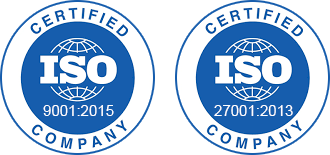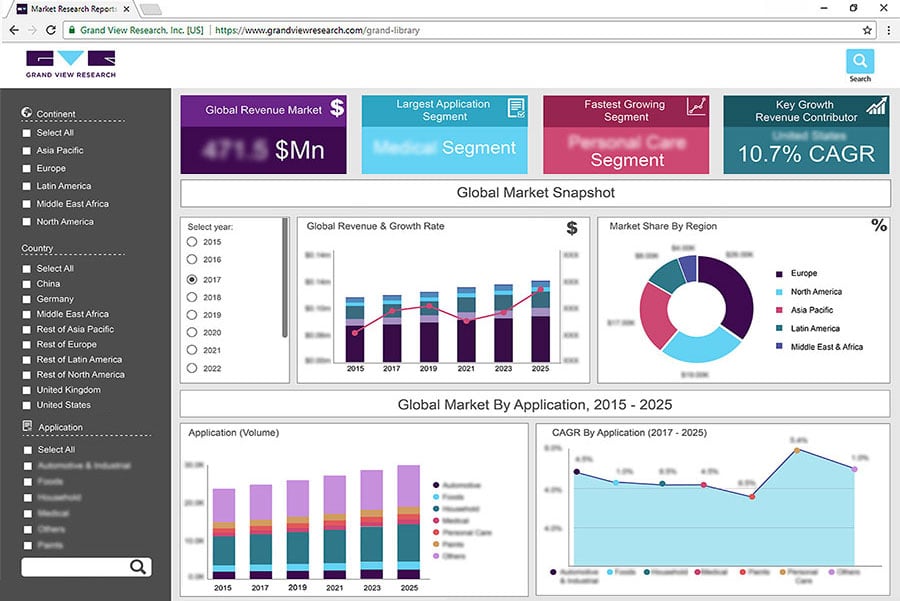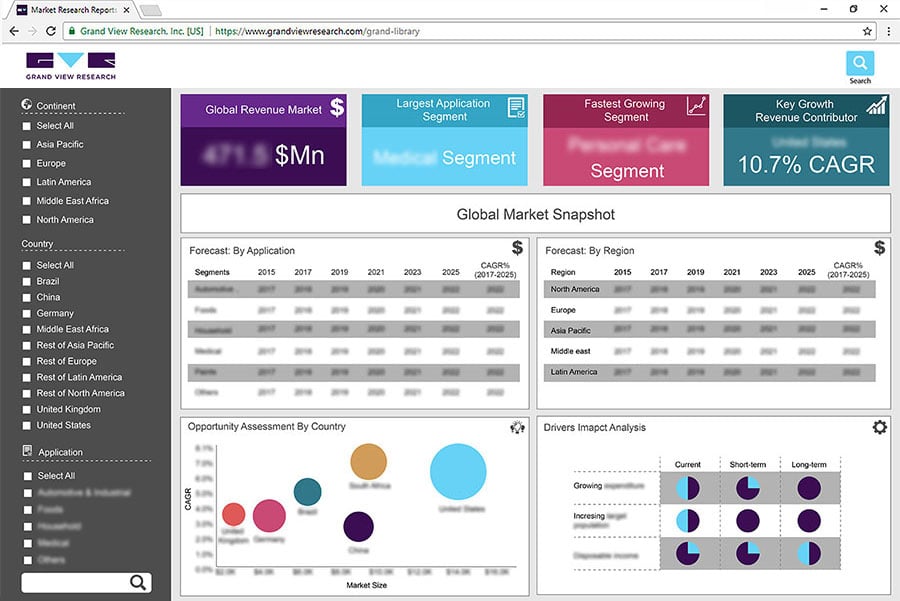- Home
- »
- Homecare & Decor
- »
-
Smart Faucets Market Size, Share, Industry Analysis Report 2019-2025GVR Report cover
![Smart Faucets Market Size, Share & Trends Report]()
Smart Faucets Market Size, Share & Trends Analysis Report By Application (Commercial, Residential), By Distribution Channel (Brick & Mortar, Online), By Region, And Segment Forecasts, 2019 - 2025
- Report ID: GVR-3-68038-271-6
- Number of Report Pages: 80
- Format: PDF, Horizon Databook
- Historical Range: 2015 - 2017
- Forecast Period: 2019 - 2025
- Industry: Consumer Goods
Report Overview
The global smart faucets market size was valued at USD 301.9 million in 2018. Shifting consumer preferences towards the smart home technology in a household on account of its high level of convenience and luxury is expected to play a key role in expanding the market size. Moreover, these advanced technologies offer better monitoring and control over water usage in households daily.
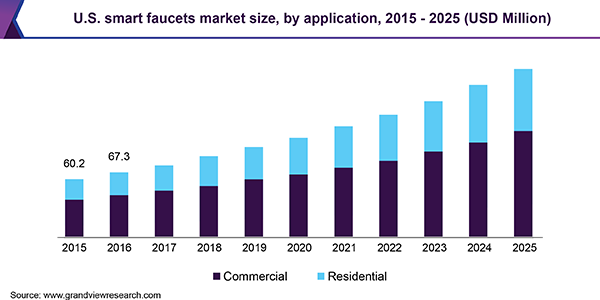
Consumer preference has shifted towards smart home technologies including smart faucets, bathrooms, electronic appliances, and even clocks. Smart faucets are gradually gaining popularity in smart home portfolios. These products are equipped with various motion sensors, touch sensors, and temperature gauges that allow customers to effectively control and monitor water consumption in the kitchen and bathrooms.
Furthermore, these products offer hands-free technology through various sensors and internet connectivity, which adds more luxury, connectivity, and convenience to the customer’s life. Touchless faucets are a crucial technology for the environment, which helps to save water in homes as well as commercial places. With conventional faucets, people waste some amount of water unwillingly during their usage. These technological products help to avoid water wastage. The aforementioned factors are expected to promote the utility of smart faucets over the forecast period.
Key manufacturers are incorporating new technologies to increase connectivity and convenience of the bathroom as well as kitchen faucets. Moreover, the industry participants are focusing on the expansion of their product portfolio by offering innovative products incorporated with artificial intelligence (AI). Key sanitary ware manufacturers including GROHE AG and Kohler Co. have developed a wide range of faucets with multiple color choices, innovative designs, and smart connectivity.
Application Insights
The commercial application segment dominated the smart faucets market, exceeding a 60.0% share of global revenue in 2018. The rapid growth of the hospitality sector in developed economies including the U.S., Germany, and France on account of the increasing number of tourists for business as well as leisure travel is expected to promote the utility of smart bathroom accessories including touchless faucets. Furthermore, improvement in the commercial real estate sector in emerging economies including China and India as a result of supportive government policies for urban development is projected to have a positive impact on the growth.
Over the past few years, UAE has invested a lot in the development of hotels, residential and commercial buildings, and tourist attractions. According to the latest report published by Alpen Capital, the hospitality market of the UAE is anticipated to reach around USD 7.6 billion by 2022, with a CAGR of 8.5%. This significant growth in the hospitality industry is anticipated to promote the utility of faucets in the commercial sector.
Distribution Channel Insights
Brick and mortar sales channel was the largest channel, accounting for a share of more than 70.0% in 2018. Renovation and inclusion of sanitary-ware experts in the company-owned stores such as Kohler, who provide the product assistance, are expected to attract the buyers over the next few years. Furthermore, in October 2017, Europe-based Villeroy & Boch announced plans to establish the direct sales of bathroom accessories for North America. This plan is expected to expand the product’s access through direct selling channels over the next few years.
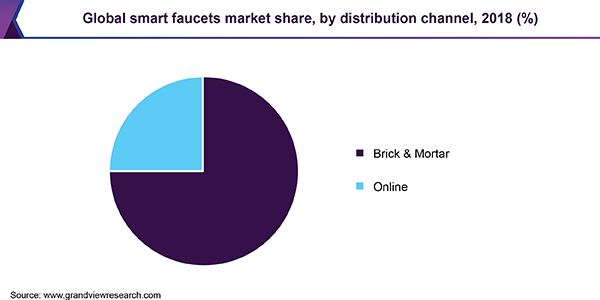
The online segment is expected to be the fastest-growing segment, expanding at a CAGR of 12.7% from 2018 to 2025 owing to the ease of shopping and convenience associated with the channels. Moreover, the increasing penetration of smartphones in the countries including U.S., Germany, the U.K., Australia, India, and China acts as the best platform for product promotion. Also, e-commerce platforms including social media and Google Ads play an essential role in influencing consumer preferences.
Regional Insights
North America was the largest market, accounting for a share of more than 30.0% in 2018 on account of increasing smart homes in the U.S. and Canada. Additionally, North America was one of the largest travel and tourism markets in the world, and the U.S., Canada, and Mexico are some of the most widely visited countries in North America. A positive outlook toward the hotel industry in the U.S. is anticipated to promote the use of smart faucets over the forecast period.
Asia Pacific is projected to be the fastest-growing market, expanding at a CAGR of 13.9% from 2019 to 2025. Growth of the residential construction sector in emerging economies including China and India owing to an increasing number of real estate projects, along with supportive home loan assistance by banks at a domestic level, is expected to have a positive impact. Furthermore, a rising number of specialty stores on sanitary ware in the aforementioned countries is expected to increase the product’s visibility over the next few years.
Key Companies & Market Share Insights
The global market is consolidated in nature owing to the presence of a large number of companies including Kohler Co., LIXIL Group Corporation, Roca Sanitario, S.A., CERA Sanitaryware Limited, Masco Corporation, and Villeroy & Boch. Furthermore, key manufacturers including Kohler Co. and DELTA Faucet Company are adopting market strategies including new product innovations to gain the maximum market share and a large customer base.
For instance, in January 2018, DELTA Faucet Company launched one of the technologically advanced smart faucets, which is powered by Alexa, an artificial intelligence (AI). The device has capabilities including Wi-Fi connectivity and voice recognition. This allows the customers to adjust the water temperature through a simple voice command. Moreover, the device can turn on or off the water supply and adjust the pressure.
Smart Faucets Market Report Scope
Report Attribute
Details
The market size value in 2020
USD 377.0 million
The revenue forecast in 2025
USD 667.3 million
Growth Rate
CAGR of 12.0% from 2019 to 2025
The base year for estimation
2018
Historical data
2015 - 2017
Forecast period
2019 - 2025
Quantitative units
Revenue in USD million/billion and CAGR from 2019 to 2025
Report coverage
Revenue forecast, company ranking, competitive landscape, growth factors, and trends
Segments covered
Application, distribution channel, region
Regional scope
North America; Europe; Asia Pacific; Central & South America; Middle East & Africa
Country scope
U.S.; U.K.; Germany; India; China; Japan; Brazil
Key companies profiled
Kohler Co.; LIXIL Group Corporation; Roca Sanitario, S.A.; CERA Sanitaryware Limited; Masco Corporation; Villeroy & Boch
Customization scope
Free report customization (equivalent up to 8 analysts working days) with purchase. Addition or alteration to country, regional & segment scope.
Pricing and purchase options
Avail customized purchase options to meet your exact research needs. Explore purchase options
Segments Covered in the ReportThis report forecasts revenue growth at the global, regional, and country levels and provides an analysis of the latest industry trends in each of the sub-segments from 2015 to 2025. For this study, Grand View Research has segmented the global smart faucets market report based on application, distribution channel, and region:
-
Application Outlook (Revenue, USD Million, 2015 - 2025)
-
Commercial
-
Residential
-
-
Distribution Channel Outlook (Revenue, USD Million, 2015 - 2025)
-
Brick & Mortar
-
Online
-
-
Regional Outlook (Revenue, USD Million, 2015 - 2025)
-
North America
-
The U.S.
-
-
Europe
-
U.K.
-
Germany
-
-
Asia Pacific
-
China
-
India
-
Japan
-
-
Central & South America
-
Brazil
-
-
Middle East & Africa
-
Frequently Asked Questions About This Report
b. The global smart faucets market size was estimated at USD 337.2 Million in 2019 and is expected to reach USD 377.0 Million in 2020.
b. The global smart faucets market is expected to grow at a compound annual growth rate of 12.0% from 2019 to 2025 to reach USD 667.3 Million by 2025.
b. North America dominated the smart faucets market with a share of 34.15% in 2019. This is attributable to growing hotel industry in the region as North America was one of the largest travel and tourism markets in the world.
b. Some key players operating in the smart faucets market include Kohler Co.,LIXIL Group Corporation, Roca Sanitario, S.A., CERA Sanitaryware Limited, Masco Corporation, and Villeroy & Boch.
b. Key factors that are driving the market growth include shifting consumer preferences towards the smart home technology in household on account of its high level of convenience and luxury as well as due to their advanced technologies which offers better monitoring and control over water usage in the households on a daily basis.
Share this report with your colleague or friend.
![gvr icn]()
NEED A CUSTOM REPORT?
We can customize every report - free of charge - including purchasing stand-alone sections or country-level reports, as well as offer affordable discounts for start-ups & universities. Contact us now
![Certified Icon]()
We are GDPR and CCPA compliant! Your transaction & personal information is safe and secure. For more details, please read our privacy policy.
We are committed towards customer satisfaction, and quality service.
"The quality of research they have done for us has been excellent."
